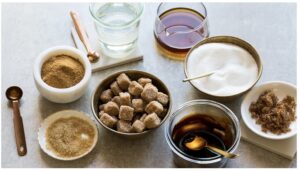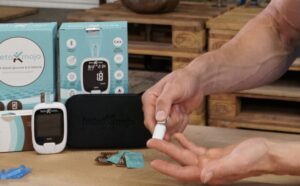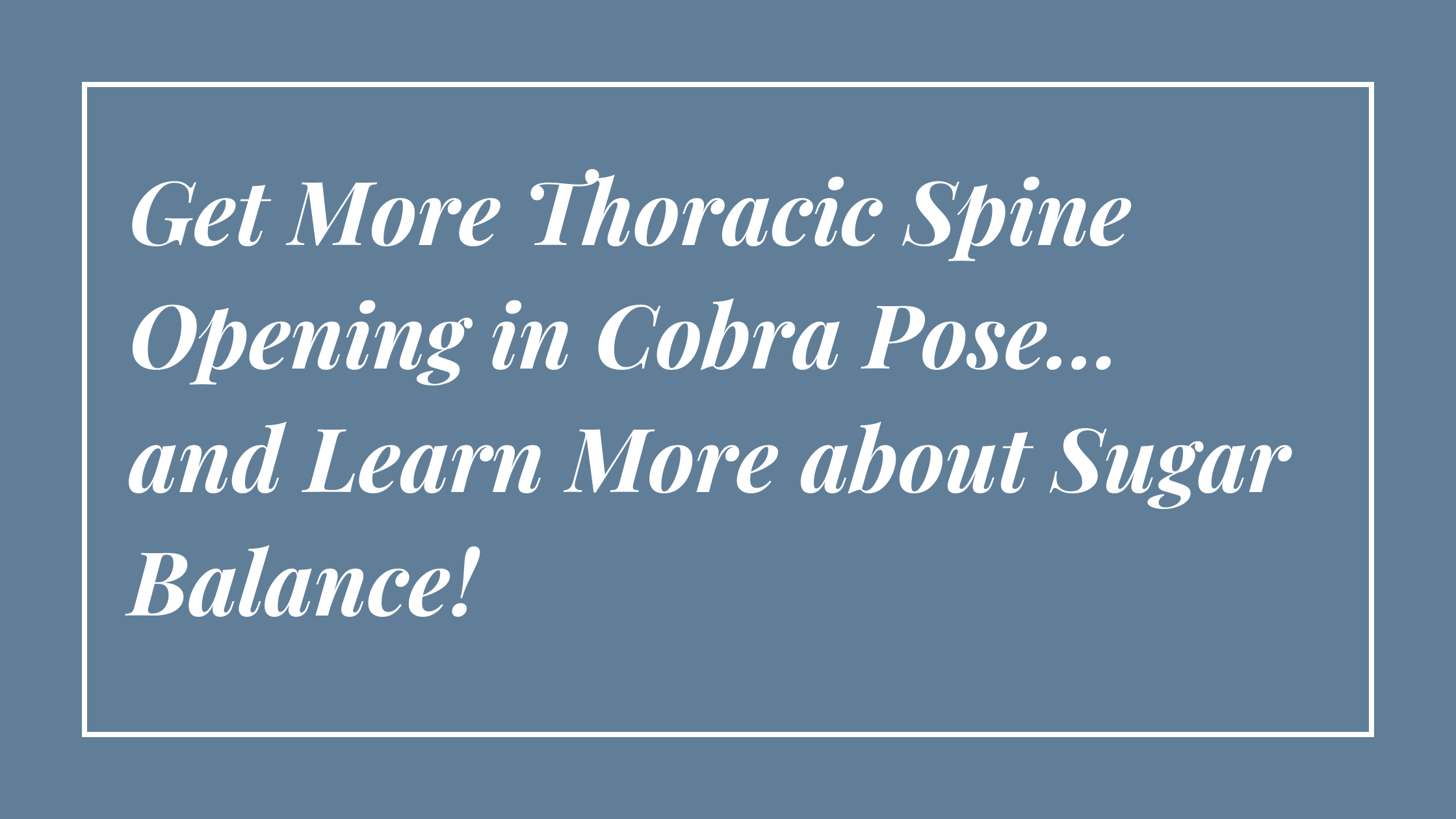One inspiring cue:
As you come into Cobra pose, keep your gaze down and chin tucked until the last moment. Then, lift your chin and gaze to the point where the ceiling meets the wall.
Why?
Many people, when coming into Cobra pose, extend their neck and not their spine, missing out on the thoracic spine opening. For me, this is the most delicious part of the pose! By keeping your gaze down and chin tucked until you reach the peak moment of the pose, you are more likely to find space in the front body first and gain optimal opening in the thoracic spine.
One inspiring tip:
Try closing your eyes and tapping into as much sensation in the thoracic spine as possible.
One inspiring song:
“Just Like Heaven, Dizzy Mix 1990” – 2018 Remake by The Cure, Bryan “Chuck” New
One inspiring quote:
“Autumn is the season that teaches us that change can be beautiful.”
Nutrition nugget:
SUGAR BALANCE
“In all human history, blood sugar problems are at an all-time high, with half of American adults and millions more worldwide being pre-diabetic or suffering from full-blown type 2 diabetes. This staggering statistic goes beyond just feeling irritable and craving sugary foods and carbs. These serious blood sugar problems are also the leading driving force behind heart attacks, strokes, and inflammation-spectrum problems at large.” – Dr. Will Cole

If anyone understands the challenge of not eating too much sugar, it’s me. But I also understand the importance of keeping blood sugar within a certain range, so it doesn’t spike too high or too low. There are many snacks and foods to choose from that have “healthy” sugar and claim they won’t spike your blood sugar. The truth is each of us is unique and responds to food differently (at the end of this newsletter, I share a way for you to actually measure your blood sugar at home).
The following is taken directly from my Functional Nutrition program. Below you will find specific details on many of the popular sugars we see in the food we eat. It is important to understand the differences between the types of sugar, the processes behind how the sugars are made, and the resulting impact on your body. This knowledge will help you discern which sugars are “better” for you than others. (Keep in mind, most of these will still raise your blood sugar, but some more than others).
Honey: Produced by bees who gather nectar from plants and begin to change it in their stomachs with enzymes, place it into a hive, and dehydrate it to form honey.
– 60-70 times sweeter than sugar
– Raw (non-pasteurized) honey contains more nutrients (enzymes, minerals, vitamins) and fiber to slow the delivery of the sugars
Unsulphered/Blackstrap Molasses: Made from the last pressing of sugarcane.
– Dark and intensely flavored with high mineral content (especially high in iron)
Maple Syrup: Comes from the sap of sugar maple trees. The sap is boiled down to produce syrup. The timing of when sap is harvested determines the color and flavor (early winter is lighter and milder, late winter is darker and stronger).
– Important to get organic, as formaldehyde pellets can be used in processing of non-organic maple syrup
Coconut Sugar: Produced from the juices of coconut palm blossoms. The nectar is collected and heated until it is dried and caramelized. Then, it is pulverized into a powder that looks much like brown sugar.
– Great low-glycemic sweetener with a nice amount of fiber, vitamins, and minerals
– Can replace regular sugar in recipes one-to-one
Dates: A natural fruit from a date palm tree.
– Fat-free and packed with fiber, antioxidants, and minerals such as iron and potassium
– Can be soaked and blended to use as a natural sweetener in baked goods and desserts
White Sugar: Made from sugarcane, beets, or corn (although most unlabeled sugar is from corn and increasingly beets).
– Highly refined and processed, usually from genetically modified (GMO) crops, and contains no nutrients or minerals
– Frequently bleached through bone char, and therefore not a vegetarian substance
Brown Sugar: White sugar with molasses added in.
Fruit Juice Concentrate: Most commonly white grape juice concentrate or pineapple juice concentrate.
– Contains few nutrients and, if not organic, can contain contaminants
Agave: A natural sweetener made from the juice of the agave cactus. It is a natural high fructose concentrate obtained by natural physical processes of extraction and purification of agave juice extract.
– Sweeter than refined sugar (about 1.4 times sweeter)
– Fructose does not stimulate digestive insulin secretion as do other sugars (less disturbing to the glycemic index)
– Will not necessarily deliver a “sugar rush”. However, fructose must be digested by the liver and consumption of high-fructose substances can result in adverse health conditions
Xylitol: A sugar alcohol made from tree fiber or corncobs. It occurs naturally in many forms, though there are components that do not break down in the small intestine. For this reason, xylitol can cause bowel disturbances.
– Low on the glycemic index and helps to prevent tooth decay
– Keep to a minimum, using only in small quantities or in chewing gum
Stevia: From a plant (stevia rebaudiana), found mostly in South America. If you’re not familiar with it, start with a little and taste as you go.
– Significantly sweeter than sugar (refined white powder stevia concentrates can be up to 300 times sweeter than sugar)
– Cannot be metabolized by our digestive tracts (making it basically non-caloric)
– Available in several forms including powdered leaves and liquid concentrates (both of which have a licorice-like taste). The leaves will not dissolve in beverages, so this form is best for cooking
– All forms of stevia mix well with other sweeteners, but it can impart a bitter taste
How can you really know if your blood sugar spikes from certain foods? A Keto Meter is a great start. This was recommended to me a while ago, and I occasionally use it to see how my glucose levels respond to certain foods. Continuous glucose monitors are becoming very popular as well. You leave the monitor on for a couple of weeks at a time and it syncs up with your phone. This way you know after every meal you eat how your blood sugar was impacted. Note that stress and sleep will affect your blood sugar as well.

For regular Yoga and Nutrition Inspiration, please follow me on Instagram @pamudellyoga.

